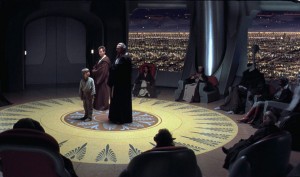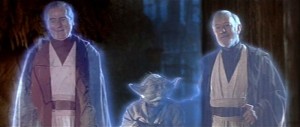Many of you will remember when Star Wars (1977) came out. It’s one of my favorite movies. The movie opened up to many of us a new world in a “galaxy far, far away”… and a new worldview in pantheism. While there are a few ideas copied from non-pantheistic traditions including Christianity— like the greeting “May the Force be with you” which is very similar to the Christian greeting “May the Lord be with you”— for the most part Star Wars portrays a pantheistic worldview. Today, the worldview of pantheism can be seen in much of our society, but when Star Wars debuted, it was still a relatively unknown and foreign concept. Pantheism gained popularity in the 1960s when Eastern ideas were taking root in the West, but Star Wars made it a star.
George Lucas borrowed themes from several Eastern pantheistic traditions, including Hinduism, Buddhism, and Daoism in creating the plotline for Star Wars. He said he wanted to inspire people to wrestle with spiritual issues. The biggest idea contained in the Star Wars films series is its idea of God. God is The Force. As Master Jedi Obi-Wan Kenobi explains to Luke Skywalker in his desert hut, “The Force is what gives the Jedi his power. It is an energy field created by all living things. It surrounds us, penetrates us, it binds the galaxy together.” Both the Jedi Knights and their adversaries, the Sith Dark Lords, use this cosmic energy to perform supernatural feats— like telekinesis, clairvoyance, precognition, and mind control. The force can also amplify physical traits like strength and speed through training.
Does this sound familiar? In pantheistic monism, the impersonal God is not separate from the universe, but contained within it, inhabiting all things. This impersonal divine energy is called by many names including the One or Brahman in Hinduism, the Void or Emptiness in Buddhism, and Chi in Daoism (Taoism) … and now… The Force. In all three traditions there is the idea that an enlightened person— through meditation, yoga, and other techniques of altering one’s consciousness— can realize this energy within. For example, you can lift an X-wing fighter out of the swamp like Yoda did only using your mind. Similarly in Daoism, you can master this energy within and perform supernatural feats. I don’t know how many times growing up I waved my hand in front of my sister’s face and said, “These aren’t the droids you’re looking for…” wishing I had mind control. That would’ve been cool.
But Lucas’s Force isn’t a non-dualistic oneness in the same way it is in Hinduism and Buddhism. It’s more like Daoism in this respect. In Daoism there are equal and opposing Chi forces that balance one another, known as the yin/yang duality. Think of the yin/yang symbol and how the black and white portions are interlocking and flowing together, and together form a perfect circle— a perfect balance. And like in Daoism’s duality, restoration of the balance of the Force is a main storyline in the Star Wars saga.
The two-sided nature of the Force propels the storyline. In the world of Star Wars, the dark side of the Force has become too pervasive, overshadowing the good side in the Galactic Empire— which has replaced the Old Republic after the Clone Wars. And this has created an imbalance and thus disharmony in the world. A central figure in the films is Anakin Skywalker (a.k.a. Darth Vader) who Master Jedi Qui-Gon Gin calls “the chosen one,” because his birth was a miraculous virgin birth (that sounds familiar too!). And Anakin’s body has a high level of midi-chlorians, which are microscopic life forms that are indicators of Force sensitivity. Qui-Gon Gin believes Anakin will restore the balance of the Force as foretold by Jedi prophecy, a hope anticipated by many throughout the film series.
And what about these Jedi? In the Discovery Channel documentary “The Science of Star Wars” Lucas revealed that he got the idea for the Jedi Knights— who have mastered the Force and are powerful warriors— from studying the Shao-Lin monks of China. These monks are Zen Buddhists influenced by Daoism who are long famous for their mastery of the martial arts, specifically Kung Fu. In Star Wars, the Jedi and Sith warriors dress in garments similar to the Shao-Lin monks, have a temple on Coruscant like the monks, a Jedi Council like the monks, and a Jedi Order similar to the monks with apprentices, knights, masters. And similar to the Daoist teaching of altering one’s consciousness for enlightenment through meditation, the Jedi are often seen “focusing their Chi” as the Shao-Lin monks call it, whereby you can tap into and direct the Chi force flowing through you with your body and your mind.
Throughout Luke Skywalker’s Jedi training with Yoda— the ultimate Jedi Master— he tells Luke to let go of the conscious mind and reach out with his feelings. For Jedi, like many Eastern pantheists, rationality is overrated; truth is found in your feelings and intuitions. We’ve passed beyond knowledge, reason, and objective truth. Feelings are central. As Yoda summarizes in Episode I, “Fear is the path to the dark side: fear leads to anger, anger leads to hate, hate leads to suffering.”
And lastly, the pantheistic ideas of reincarnation, liberation from desires, and spirit guides can be seen in Star Wars. For when people die they are absorbed into the Force, much like the cycle of rebirth. In Episode III Yoda warns Anakin not to grieve over his wife’s death for “death is a natural part of life. Rejoice for those around you who transform into the Force.” A Jedi should accept it without emotion. Anakin must not become attached to things or people for attachment leads to jealousy and the dark side. He must release all feelings from things— for its only when you do that that your thinking is clear. Doesn’t this ring of Hinduist and Buddhist teaching of liberation from all worldly desires as the way to avoid suffering? Daoism also reflects this idea. It says that the way to recover harmony is surrender, tranquility, and nonattachment. But when a Jedi dies, that’s a different story. For they are able to delay this absorption and appear as spirit guides to help those still in the world, much like the Daoist belief that Daoist masters become spirit-like beings interacting with earthly beings.
Many people have taken this pantheistic idea of the One, Void, Chi, or Force to be the same idea as the Holy Spirit in Christianity, but this is mistaken. The main Eastern conception of God says that he/it is an impersonal energy field. Conversely, in Christianity, the Holy Spirit is a personal, eternal being with personality, intelligence, and will; the third member of the Trinity. And unlike this divine energy, which is made up of all living things in the universe, the Holy Spirit is not contained in the universe, but is involved in the universe, existing independently of our universe like God the Father and God the Son. Third, the divine energy can be manipulated in Daoist philosophy and Star Wars mythology by priest warriors who use it to do what they want. But the Holy Spirit can’t be manipulated by us, those He indwells. Instead, He guides, teaches, comforts, and empowers us to do the will of God the Father. Christians don’t master the Holy Spirit as if we are god-like beings. It’s the other way around. The Holy Spirit guides us to do God’s will. And lastly, the divine energy has a good side and a dark side in Daoist and Jedi tradition, which exists in a state of balance. But the Holy Spirit has no dark or evil side; only the same attributes as a holy and good God.
For me, these pantheistic underpinnings don’t make me shy away from watching these types of movies. Nor do I watch them as a naive consumer stuffing it into my brain along with the popcorn. I watch these movies with discerning glasses on and a baloney detector in my hand. I think that movies are a great way to flesh out philosophies, ideas, and ultimately worldview orientations and make them real and understandable. It doesn’t mean I’m going to believe them, but I will think about them and enjoy the ride.
(On a side note, I recently came across a video parody that is a mashup of Star Wars and Frozen. It’s hilarious and worth watching.)
[amazon text=Amazon&template=carousel&asin=B00003CX5P,B00006HBUJ,B00005JLXH,B000FQJAIW,B0006VIXGQ,B000FQJAIW]


